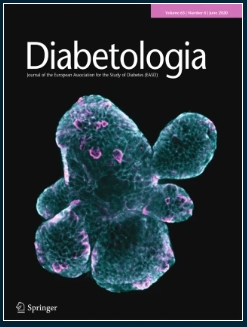1型糖尿病患者在冷水中运动是否比在热中性条件下运动更容易患低血糖?
IF 8.4
1区 医学
Q1 ENDOCRINOLOGY & METABOLISM
引用次数: 0
摘要
目的/假设本研究的目的是验证1型糖尿病患者在冷水中运动比在热中性水中或陆地上运动更能降低血糖浓度的假设。方法8名夜间禁食的1型糖尿病患者(18-40岁)在以下条件下,在陆地上V˙o2峰值的40%完成了3 × 60分钟的自行车运动:浸泡在冷水(22°C)或热中性水(32°C)或热中性(22°C)的陆地上。在一定的时间间隔内,测量以下变量:血糖和血浆胰岛素浓度、皮肤血流量、皮肤温度、碳水化合物和脂肪氧化率。结果在冷水和热中性水中骑行时血糖浓度无明显变化(p<0.05),而在陆地上骑行时血糖浓度下降(p<0.05)。血浆胰岛素浓度在冷水循环过程中和循环后早期下降(p<0.05)。在24°C下,冷水循环后60 min的陆地恢复期间,血糖浓度显著升高(~2 mmol/l, p<0.05),而在热中性水和陆地循环后,血糖浓度无显著升高。结论/解释:1型糖尿病患者在基础胰岛素状态下,在冷水中进行40% V˙o2峰值的运动,其血糖浓度的下降并不比在热中性水中或在陆地上更明显,但在陆地恢复过程中,血糖升高较早,可能是由于血浆胰岛素的短暂下降。本文章由计算机程序翻译,如有差异,请以英文原文为准。
Does exercise in cool water cause a higher risk of hypoglycaemia than in thermoneutral conditions in type 1 diabetes?
AIMS/HYPOTHESIS
The aim of this study was to test the hypothesis that exercise in cool water results in a greater decrease in blood glucose concentration than in thermoneutral water or on land in individuals with type 1 diabetes.
METHODS
Eight overnight-fasted individuals (aged 18-40 years) with type 1 diabetes completed 3 × 60 min cycling sessions on an ergometer at 40% of their on-land V ˙ O 2peak under the following conditions: while immersed in cool water (22°C) or in thermoneutral water (32°C) or on land at thermoneutrality (22°C). At time intervals, the following variables were measured: concentration of blood glucose and plasma insulin, skin blood flow, skin temperature and rate of carbohydrate and fat oxidation.
RESULTS
Blood glucose concentration did not change in response to cycling while immersed in cool or thermoneutral water (p>0.05) but decreased during cycling on land (p<0.05). The concentration of plasma insulin decreased during and early after cycling in cool water (p<0.05). During 60 min of on-land recovery (at 24°C) after cycling in cool water, blood glucose concentration increased significantly (~2 mmol/l, p<0.05), but not after cycling in thermoneutral water or on-land.
CONCLUSIONS/INTERPRETATION
Exercise at 40% V ˙ O 2peak performed in a basal insulinaemic state in cool water in people with type 1 diabetes does not cause a greater decrease in blood glucose concentration than in thermoneutral water or on land, but blood glucose increases early during on-land recovery, probably as a result of a transient fall in plasma insulin.
求助全文
通过发布文献求助,成功后即可免费获取论文全文。
去求助
来源期刊

Diabetologia
医学-内分泌学与代谢
CiteScore
18.10
自引率
2.40%
发文量
193
审稿时长
1 months
期刊介绍:
Diabetologia, the authoritative journal dedicated to diabetes research, holds high visibility through society membership, libraries, and social media. As the official journal of the European Association for the Study of Diabetes, it is ranked in the top quartile of the 2019 JCR Impact Factors in the Endocrinology & Metabolism category. The journal boasts dedicated and expert editorial teams committed to supporting authors throughout the peer review process.
 求助内容:
求助内容: 应助结果提醒方式:
应助结果提醒方式:


